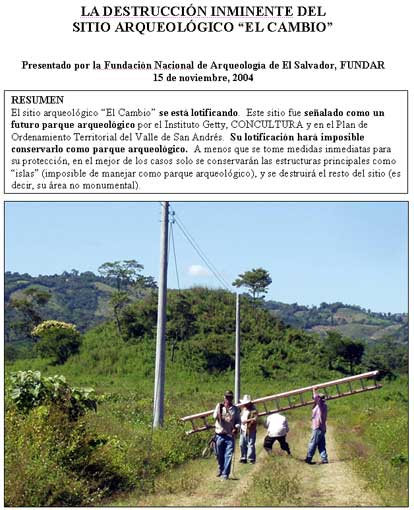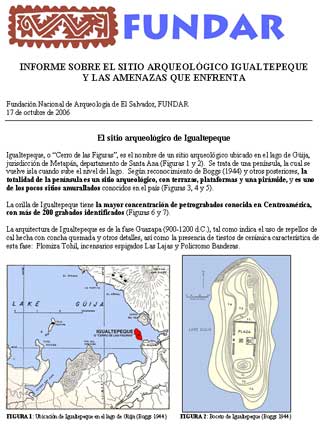Our Fight Against Looting and Illicit Traffic of Artifacts
FUNDAR's Position on Archaeological Pillage and Illicit Traffic of Artifacts
Reports of Looting and Site Destruction, Some Examples
La Cuchilla Archaeological Site
Tapalshucut Archaeological Site
Destruction of Pyramids at Guazapa
Las Marías Archaeological Site
San Andrés Archaeological Site
Igualtepeque Archaeological Site
Chuchucato Archaeological Site
Reports Denouncing the Commercialization of Salvadoran Artifacts through the Internet
Participation in Investigations with the Police, Interpol, and Fiscalía
Evaluations of Confiscated Artifacts
Protection Measures for Archaeological Sites
Contributions to International Agreements Against Illicit Traffic
FUNDAR's Postion on Archaeological Pillage and Illicit Traffic of Artifacts
FUNDAR condemns the looting and destruction of archaeological sites and of cultural heritage in general.
FUNDAR condemns the commercialization of archaeological artifacts and other cultural property.
Actions by FUNDAR Against the Destruction of Cultural Heritage and Illicit Traffic of Artifacts
FUNDAR has done more than any individual or group in fighting the destruction of Salvadoran cultural heritage and illicit traffic of artifacts. We summarize these actions below.
Reports of Looting and Site Destruction
FUNDAR has presented over 30 reports to the cultural authorities concerning the destruction of archaeological and historic heritage. Here follow some examples ranging from 2000 to 2009. As a consequence of these denouncements, on several occasions FUNDAR has been called to give testimony in the resulting legal cases.
Mucuyo Archaeological Site (Jurisdiction of San Rafael Cedros), 2000
A Late Classic site was partially or completely destroyed by a subdivision. Denounced by FUNDAR to CONCULTURA.

The pyramid at Mucuyo (right) and the remains of 2 destroyed platforms (left).
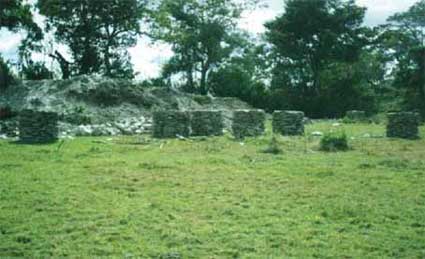
When the subdivision of Mucuyo began, 2 platforms faced with slabs were destroyed. In this photo, the slabs are neatly arranged in piles, ready for sale. The mound of white earth is from the fill of the platforms. It was rumored that one of the destroyed platforms held a tomb containing many ceramic vessels.
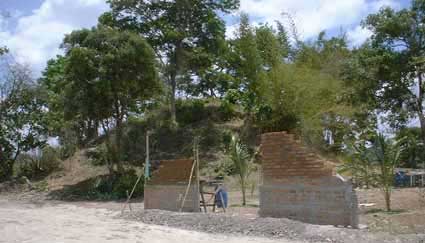
Acting on information from locals, FUNDAR recorded this previously unknown site and informed the Department of Archaeology (CONCULTURA) about this urgent situation. One year later we made another visit to the site. The owner of the lot encompassing half of the pyramid was just beginning construction.
La Cuchilla Archaeological Site (Ciudad Arce), 2001
A major pyramid (part of a mostly-destroyed Late Preclassic site) was being seriously damaged by a bulldozer leveling adjacent ground for a soccer field, and by the excavation of a large drainage channel. There was also evidence of recent looting on top of the pyramid. FUNDAR denounced the situation to CONCULTURA.
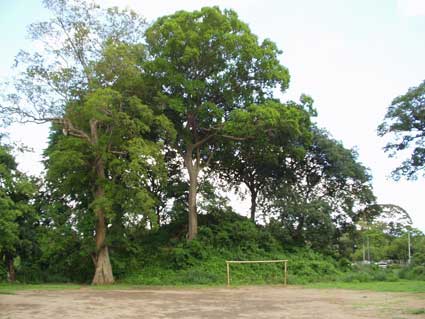
Leveling work by a bulldozer damaged the site up to the pyramid's base.
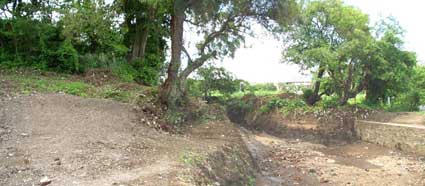
A drainage channel was being excavated next to the pyramid, destroying part of its base.
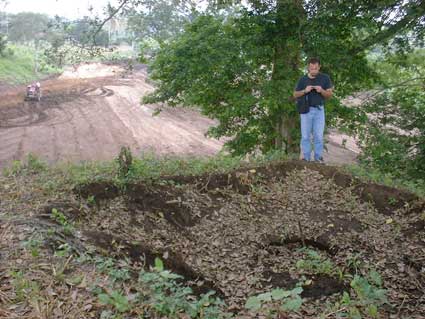
Fabio Amador (Archaeologist, FUNDAR) photographs the looter's pit on top of the pyramid. In the background, a bulldozer levels part of the non-monumental site area, part of which is now covered by buildings.
Discovery and Theft of Sculptures, Tapalshucut Archaeological site (Izalco), 2002
The Tapalshucut archaeological site dates to the Late Preclassic period and is located north of Izalco. It was discovered when a school was being built. The excavation for its foundations exposed a group of 7 stone sculptures, 2 of which were stolen immediately. The school's director, Morena Méndez, managed to lock the other 5 in a tool shed. Carlos Leiva (cultural advocate from Izalco) notified CONCULTURA about this situation; after several days with no response (and with the remaining sculptures in the unsecure shed) he called FUNDAR. We visited the site right away and recorded it with the assistance of Leiva and Ricardo Salazar. The information was given to CONCULTURA, including recommendations for safeguarding the sculptures and for the protection and investigation of the site.
Amaroli and Karen Bruhns published an article about this discovery later in the same year (click here to read the article)
Subsequently, Marlon Escamilla (Department of Archaeology, CONCULTURA) determined that the site has 3 pyramids and some fragments of columnar basalt which had been placed in their vicinity as monuments. The sculptures were moved to the National Museum and will hopefully be returned to Izalco at such time when a local museum exists with adequate security.
In view of the interest of the Izalco city council in this discovery, FUNDAR recommended that they lend their support to archaeologist Federico Paredes for further investigations at Tapalshucut. Paredes received their support, as well as that of Carlos Leiva and Ricardo Salazar, including lodging and other resources for his preliminary investigation. The future of Tapalshucut remains undefined
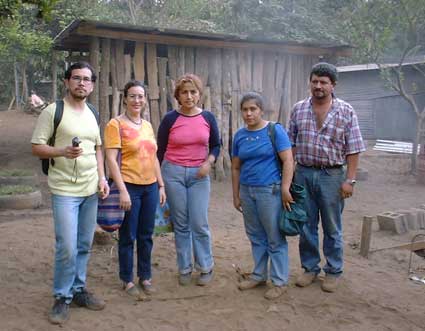
The school's director, Morena Méndez (at center) was able to place the 5 sculptures to the shed visible in the background - not very secure, but it kept them safe until they could be moved to the National Museum. Carlos Leiva and Elizabeth Trabanino appear to the left, with Ricardo Salazar on the right.
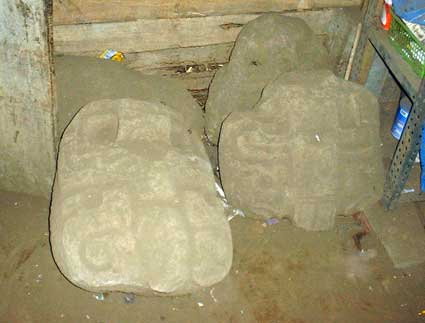
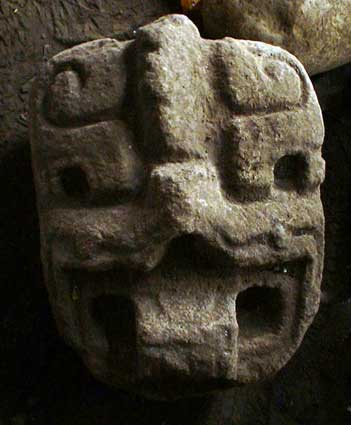
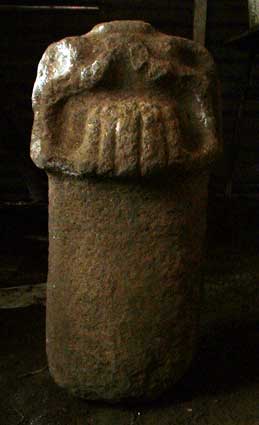
Left: The sculptures as found in the shed. Center: One the 3 sculptures in form of a head. Since many years ago, this style of Preclassic sculpture has been referred to as "Jaguar Effigy Heads", although another possibility is that they represent serpents. Right: One of the other sculptures. That same year, Amaroli and Karen Bruhns published information about this find [“Jaguar Face” Sculptures Found in El Salvador. Mexicon XXIV (5), October, 2002].
Destruction of Pyramids at Guazapa, 2004 and 2005
FUNDAR denounced to CONCULTURA the destruction of 2 pyramids in the jurisdiction of Guazapa. The destruction was in part looting for artifacts and in part to obtain stone for sale as construction material.
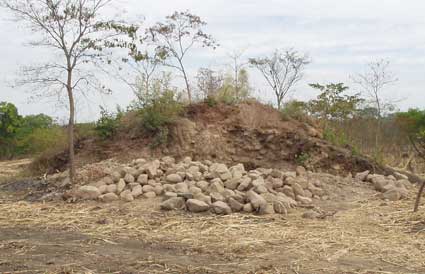
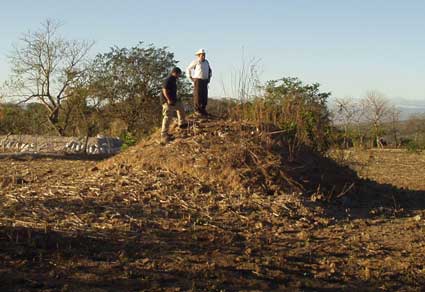
Vladimir Avila (Archaeologist, FUNDAR) examines two nearly-destroyed pyramids. Left: Half of this pyramid was found destroyed, with its stone piled for sale. Right: The stone facing of this pyramid had been removed, leaving this sad vestige of its core. Both pyramids are now completely destroyed
Las Marías Archaeological Site
Since the year 2000, FUNDAR has presented several reports to the cultural authorities about incidents of damage, destruction, and looting at Las Marías, as well as about the "coyotes" (illicit buyers/sellers) of artifacts that encourage residents of the area to loot.
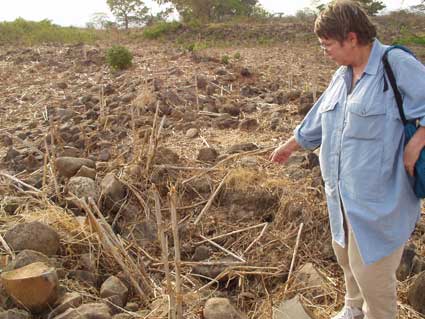
Karen Bruhns (Archaeologist, FUNDAR) points at a recent looter's pit at Las Marías.
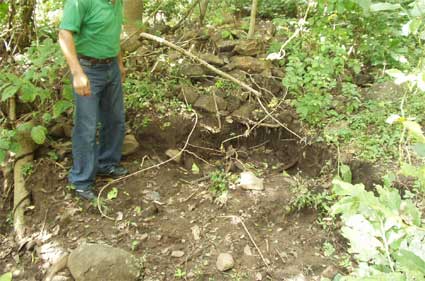
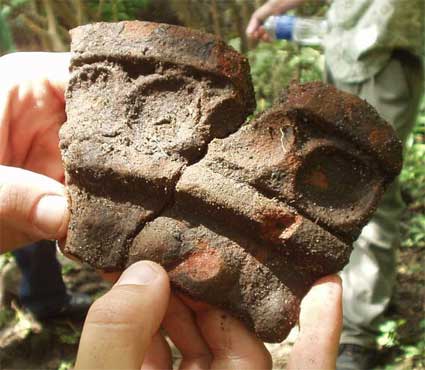
The effects of looting of a small platform at Las Marías, where fragments of an incense burner were exposed. In their usually futile search for marketable artifacts, looters cause permanent damage and destruction of architecture, burials, and other archaeological features.
FUNDAR ha requested that Las Marías be declared a National Monument by the National Assembly.

Following FUNDAR's proposal to name Las Marías a National Monument, we accompanied the National Assembly's Commission on Culture and Education on a fieldtrip to the site. Rodrigo Brito (President of FUNDAR) stands with deputies from the National Assembly on the main pyramid.
Punián Archaeological Site (Department of San Salvador), 2004 and 2008


Punián (a Late Classic site) has been intensively looted over many years time. The main pyramid (left) has been gutted. Looters' pits cover the site (right, full of fallen leaves).
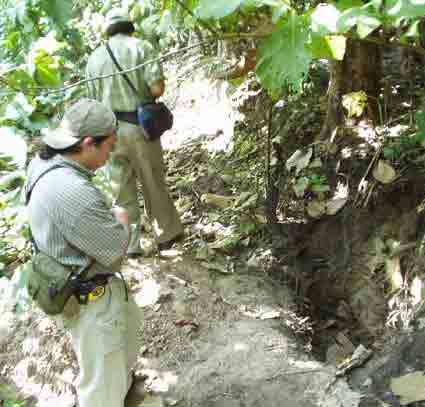
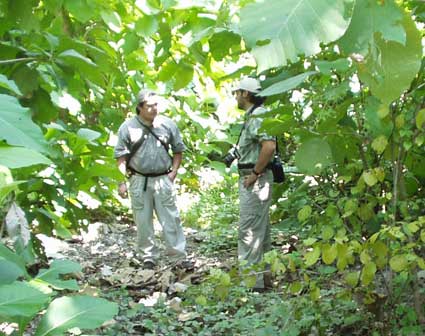
FUNDAR has made two official denouncements of looting at Punián. In 2004, we reported new incidents of looting and the wholesale destruction of the eastern edge of the site by bulldozer, and later we took Archaeologists Marlon Escamilla and Heriberto Erquicia (CONCULTURA) to inspect the damage. In 2008 we reported plans to destroy the rest of the site either by a subdivision or a cemetery project.
Asanyamba Archaeological Site (Department of La Unión), 2004
This site is a shell mound dating from the Late Classic period. This locality is traditionally known as Chapernalito. In the late 1970s, Archaeologist Stanley Boggs coined the present name for the site using roots from the Potón (Salvadoran Lenca) language, which he intended to mean "hot place" - very appropriate given its torrid climate. Shells are extracted by locals who grind them up and sell them to chicken farms as a source of calcium; they also take advantage to loot the site which also contains burials with offering and other features. In 2004 we informed CONCULTURA that the illicit excavations at Asanyamba, which had been suspended years before, had begun anew.
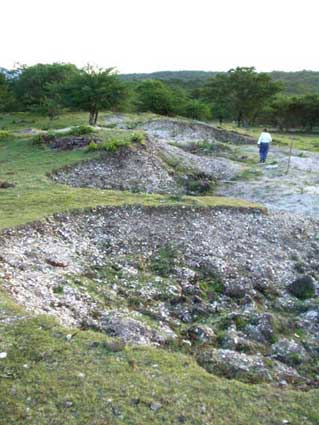
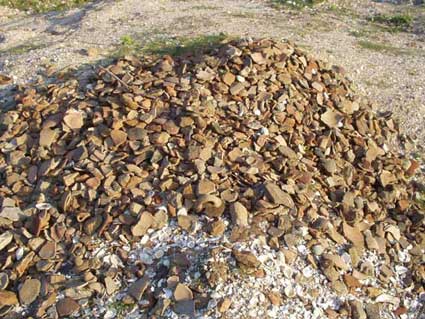
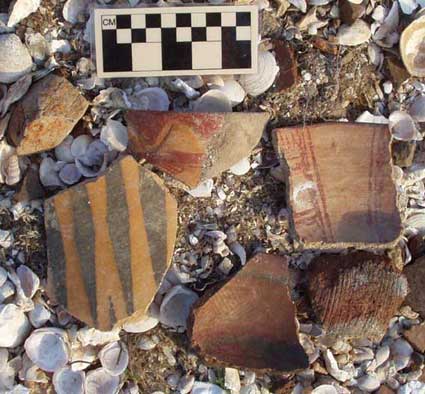
Above: A general view of the huge gouges in this large shell mound left by people who extract shells and also loot artifacts. Below: The excavators pile up those fragments they consider as worthless.
El Cambio Archaeological Site (Department of La Libertad), 2004
FUNDAR was the first to denounce the imminent destruction of El Cambio, an important site with occupation ranging from the Preclassic through the Late Classic when it became a secondary regional center, possibly with nearby Joya de Cerén as one of its subject communities.
Cover page of the report from FUNDAR to CONCULTURA about the imminent destruction of the El Cambio archaeological site (November 15, 2004). At that time, there was only minor new damage to the site, consisting of a few power poles. Click here to read the report.

Above: The main pyramid at El Cambio surrounded by a road just opened with a bulldozer. Below: A recent photo of the subdivision which will almost completely cover this archaeological site.
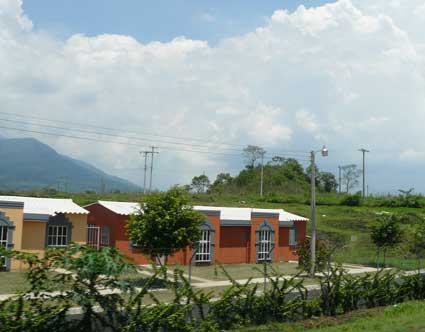
San Andrés Archaeological Site (Department of La Libertad)
San Andrés is a very extensive site. The archaeological park includes about 1/4 of the site area, while the remainder - over 100 hectares (over 250 acres) is in private hands and has been severely affected by sugar cane cultivation, some buildings, and intensive looting. Incidents of looting have been denounced by FUNDAR on many occasions since 2005.
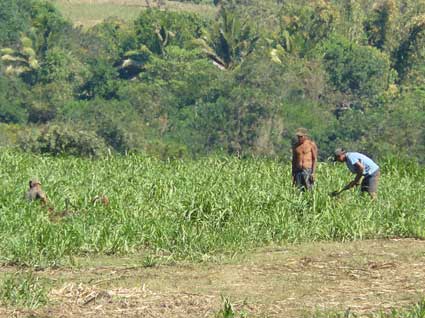
Above: A telephoto view of looters digging in the sugar cane fields north of the archaeological park.
Below: Looters' pits west of the park.
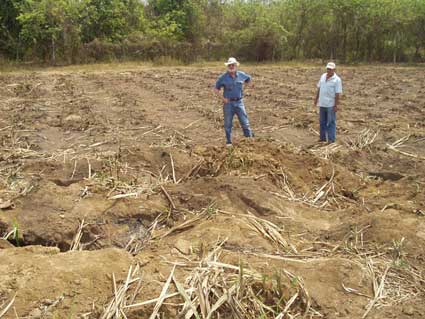
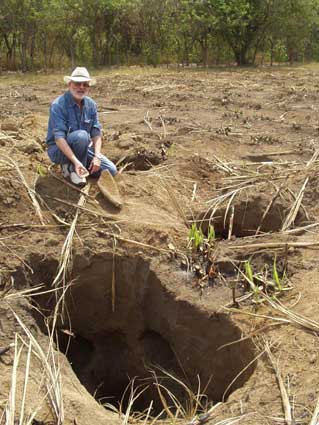
Igualtepeque Archaeological Site (Department of Santa Ana), 2006
The Igualtepeque archaeological site occupies a peninsula in Lake Güija, which becomes an island when the lake level rises in the rainy season. The site is now known locally as "Cerro de las Figuras" because of its petroglyphs. As described by Stanley Boggs in 1944, this peninsula was greatly modified in prehispanic times, forming a series of terraces and leveling its summit where a pyramid and other structures were erected. The summit is partially enclosed by a wall. The shore of Igualtepeque has over 80 boulders with petroglyphs (studied by Andrea Stone), making it one of the most outstanding rock art sites in the region. The principal occupation of Igualtepeque is Early Postclassic (and it is culturally affiliated with Cihuatán). A notable artifact found on the lake bed next to Igualtepeque is a plaque from the Maya Lowlands, with Maya writing and the portrait of a ruler. The site has suffered many incidents of looting which have been denounced by FUNDAR to CONCULTURA.
There exist two versions about the ownership of Igualtepeque. The first, which is supported by an official map of national lands, is that it is public land. The second version is that it is private. We have urged the government to resolve this key point.
In 2006, callers informed FUNDAR that an individual had purchased the site and was going to build a tourist resort including a hotel, restaurant, and water slides. Any development at Igualtepeque would seriously damage the site, or destroy it altogether. FUNDAR prepared a report about the importance of Igualtepeque and the danger of its destruction, detailing the persistent problems of looting and theft of stones with petroglyphs, and informing about the new threat of development. You may view the report by clicking here.
CONCULTURA did not give permission for the development. Subsequently, the site has been offered for sale in classified ads (the price is reportedly $2,000,000.00). The future of this site is not defined.
Cover page of the report presented by FUNDAR to CONCULTURA in 2006.
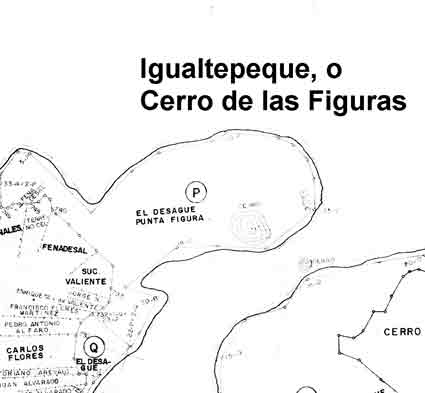
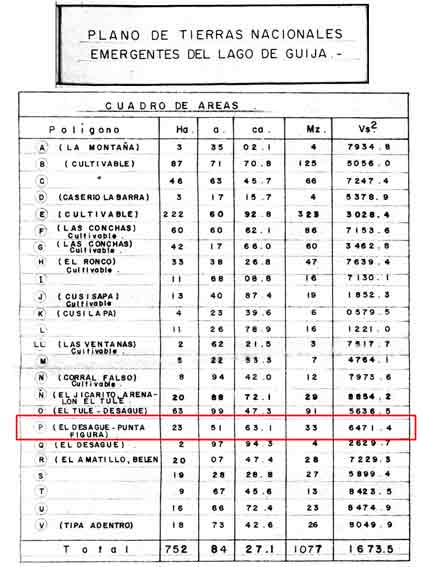
This section of a map of national lands in the area of Lake Güija clearly identifies Igualtepeque ("Polígono P", "Punta Figura") as state property with an area of 23.5163 hectares (the map was evidently prepared in the dry season when the lake is at its lowest and Igualtepeque's surface area is at its greatest). In the report mentioned above, and on other occasions, FUNDAR recommended that CONCULTURA ascertain the legal ownership of the site. If it is indeed state property, then guards should be posted immediately to stop looting, but this key point has yet to be resolved.
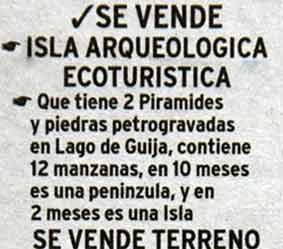
Igualtepeque is offered for sale in this classified ad from a Salvadoran newspaper (2008).
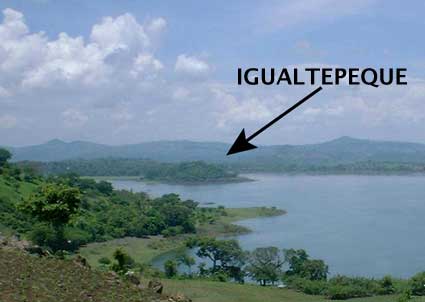
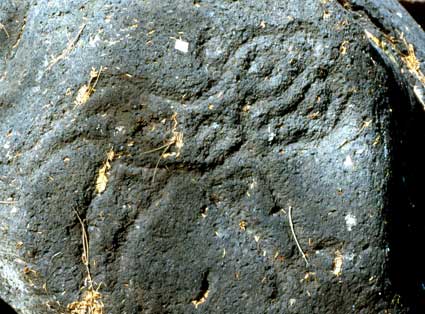
Left: Igualtepeque's peninsula is located at the eastern end of Lake Güija. Right: The shore of the site has over 80 boulders with petroglyphs, such as this jaguar. Some of the smaller boulders have been stolen in recent years.
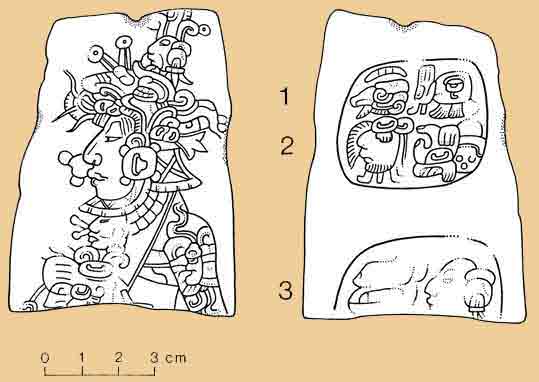
An important artifact associated with Igualtepeque is this greenstone plaque found by a diver in the turbid waters next to Igualtepeque. Its style clearly identifies it as a product of the Early Classic Maya Lowlands. The fine incisions on one side (left) represent the portrait of a Maya ruler, while the other side has glyphs arranged in cartouches. The ruler's name appears in the second element of row 3, and is also present in the headgear of his portrait. The lower portion of this plaque is missing (the break is apparently ancient). Drawing taken from the article The Lake Güija Plaque, by Stephen Houston and Paul Amaroli (1988), Research Reports on Ancient Maya Writing 15. Center for Maya Research, Washington, D.C. Click here to consult this article.
Shuteca Archaeological Site (Department of Sonsonate), 2007
Construction work for a municipal recreational center next to the Shuteca River destroyed part of a Late Classic site. FUNDAR recorded the site and informed CONCULTURA about the need for salvage investigations and protection of the remaining site area.
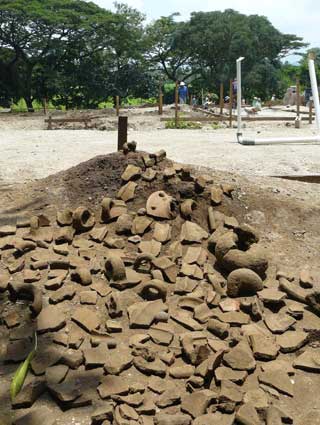
At Shuteca, construction work destroyed remains of Late Classic domestic occupation.
Chuchucato Archaeological Site (Department of La Libertad), 2009
FUNDAR denounced to CONCULTURA the beginning of a subdivision at this site. One structure at Chuchucato is a large platform supporting a pyramid.
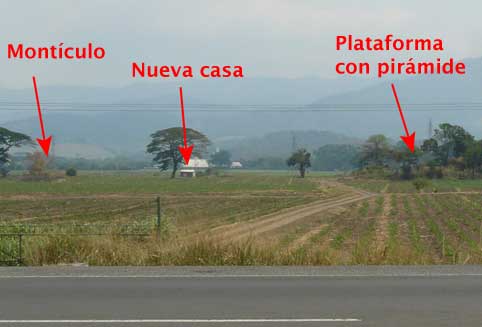
View of Chuchucato taken in 2009. The labels are (from left to right), Mound, New House, Platform with pyramid.
Santiago Aculhuaca Colonial Church (Ciudad Delgado), 2000
FUNDAR also denounces the destruction of historic heritage, such as was the case in the year 2000 concerning the imminent destruction of the colonial church of Santiago Aculhuaca as planned by its parish priest (a Belgian) who, as he told us, belittled Spanish relics and wanted a new church. While this church had many recent modifications, it still preserved its unique colonial columns crowned with carvings of the imperial Hapsburg bicephalic eagle. The light damages sustained by the church in the 2001 earthquake were used as a pretext in order to rush its demolition.
All colonial churches must also be considered as archaeological sites. Their floors, atriums, and surroundings typically contain hundreds, or thousands, of burials dating from their foundation (generally in the 16th century) until the establishment of municipal cemeteries in the 19th century. They often also preserve evidence of prior construction stages of the Colonial period. In one known case (the Nuestra Señora de la Asunción Colonial Church in Ahuachapán) investigations have shown that the church was build on a prehispanic mound dating from the Late Preclassic which had been abandoned for over 1,000 years when the church was erected upon it.
But no archaeological work was done at this or any of the other churches mentioned here. And we must ask: where are this church’s ancient columns and altars now?
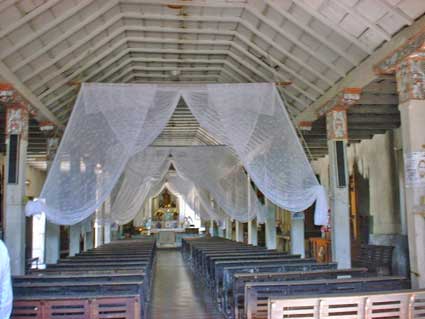
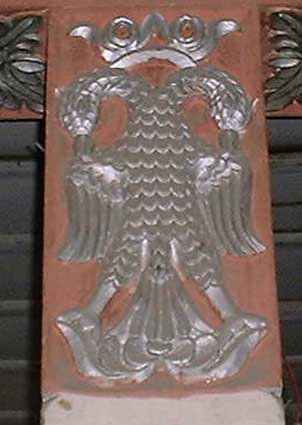
Left: The interior of the Santiago Aculhuaca Colonial Church. Right: one of the colonial columns, carved with the insignia of the Hapsburg Empire (covered by recent silver-colored paint).
Nahulingo Colonial Church (Department of Sonsonate), 2008
On February 4, 2008, FUNDAR denounced to CONCULTURA the imminent destruction of the ancient church of Nahulingo, another instance where the parish priest wanted a "modern" temple. In our visit on that date, we documented that the roof had already been removed which, as related by locals, was done so that the rain would begin the work of destruction, then serving as a pretext for its demolition. Despite the urgent warnings, on the night of February 26, the parish priest organized several men armed with picks and in that single night threw the thick church walls to the ground. The church had a entry carved in stone, apparently unique in El Salvador.
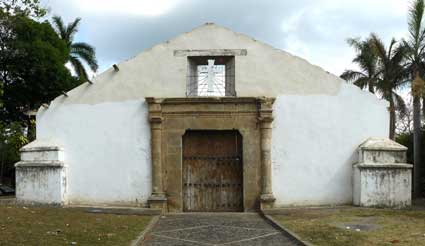
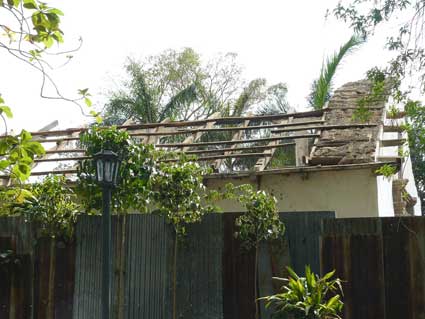
Photographs from February 4, 2008. The roof had already been removed from the Nahulingo Colonial Church. Below, its unique entry of carved stone.
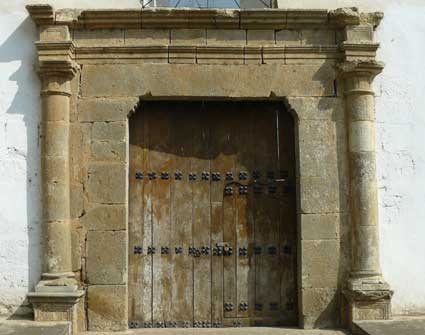
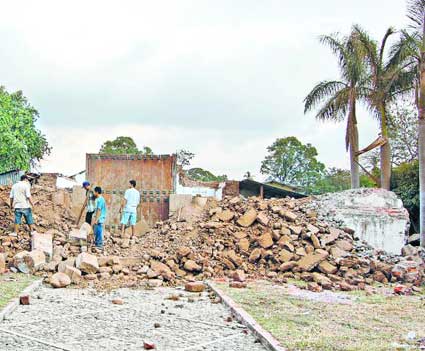
February 27, 2008. The thick adobe walls were destroyed in a single night by direction of the parish priest (photo from the Diario de Hoy newspaper).
Reports Denouncing the Commercialization of Salvadoran Artifacts through the Internet
A new and growing problem in the illicit traffic of artifacts is their sale through the Internet. It is obvious that certain individuals are exporting large quantities of artifacts from El Salvador in order to sell them through "galleries" generally located in the United States. Some of these are real galleries with physical spaces, others are not, but in both cases the Internet is being used to sell artifacts. Some individuals are also using ebay.com to make direct sales.
On two occasions, FUNDAR has given the cultural authorities extensive lists of Internet addresses where Salvadoran artifacts are being sold. It is very important to block this new market for illicit traffic.
If you wish to delve deeper into this matter, we suggest you begin with a Google image search of the word "Copador". Copador Polychrome is a common type of ceramic in the territory of El Salvador (although its range of distribution extends somewhat beyond, in particular including the area of Copán). Your search results will include several of these merchants of looted artifacts.
As described below (see Evaluations of Confiscated Artifacts, in 2008 action was taken on the sale of Salvadoran artifacts on eBay.com, but we must note that this was at the iniciative of US Customs and Border Protection of the Department of Homeland Security.
Participation in Investigations with the Police, Interpol, and Fiscalía
On several occasions, the denouncements made by FUNDAR have resulted in investigatons where FUNDAR has given legal testimony and in field visits with the Police, Interpol, CONCULTURA, and Fiscalía (the equivalent of the DA's office).
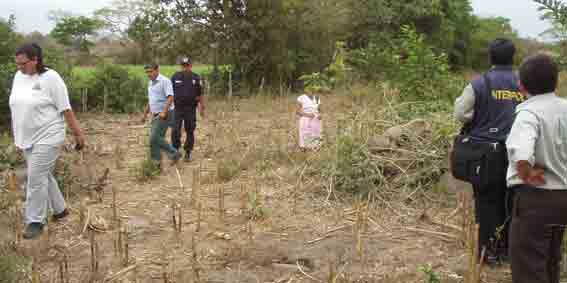
Members of FUNDAR on a field visit with representatives of CONCULTURA, the National Police, Interpol, and Fiscalía in order to investigate looting at Las Marías reported by FUNDAR.
Evaluation of Confiscated Artifacts
FUNDAR archaeologists Karen Bruhns and Paul Amaroli have made expert evaluations for the US government of archaeological artifacts confiscated in the United States.
The first case was the confiscation in San Francisco, California, of 3 boxes artifacts from El Salvador. US Customs requested the evaluation of the 42 objects contained in the boxes. According to the evaluation, 39 were prehispanic and characteristic of the area of El Salvador, while 3 were possibly falsifications. Consequently, all the objects were returned to El Salvador and deposited in the National Museum.
This was historically the first repatriation of Salvadoran artifacts from the United States.
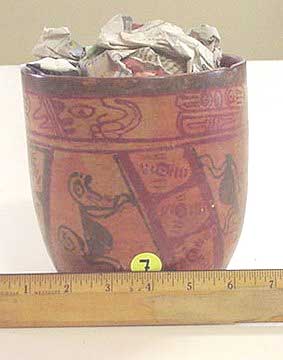
One of the 42 objects confiscated in San Francisco, California (a Gualpopa Polychrome vessel).
The second case is still an active judicial process in El Salvador, because of which we may only say that it concerns massive sales of Salvadoran artifacts through www.ebay.com. In 2008, FUNDAR collaborated in this case with the evaluation of several artifacts by Karen Bruhns and Paul Amaroli (click here to read the evaluation). You may read articles published about this case on May 12, 2010, in our News section.
Protection Measures for Archaeological Sites
Thanks to the actions of FUNDAR, since 2007 the two largest archaeological sites known in El Salvador now have the full protection granted by the cultural heritage law ("Ley Especial de Protección al Patrimonio Cultural de El Salvador").
FUNDAR conducted surveys to determine the limits of the Cihuatán and Las Marías archaeological sites. These limits were then described as topographical polygons based on geodesic points (the report of the work at Cihuatán may be accessed by clicking here. FUNDAR prepared a list of protection measures (use restrictions) to be applied within these polygons, in accordance with the provisions of the law. This information was given to CONCULTURA and took legal form with its official publication in 2007 (the resolutions for each site may be seen by clicking on their names: Cihuatán Las Marías). With the direct collaboration of FUNDAR, the limits of Cihuatán have been incorporated in the geographic information system (GIS) used by the government agency responsible for national mapping (the Centro Nacional de Registros), so that this information may be fully available to planning agencies. We hope that the information for Las Marías is now also in this GIS.
In addition to keeping this information in a GIS, it is very important to mark the geodesic reference points with durable benchmarks in the field as a direct reference for property owners and others.
These are the first archaeological sites in the country with this type of description and with legal protection based on geodesic polygons incorporated in the official GIS.
Any other site in the country can have this same type of protection, but it is necessary that archaeologist undertake the necessary fieldwork to determine site limits (this took several years for Cihuatán and Las Marías).
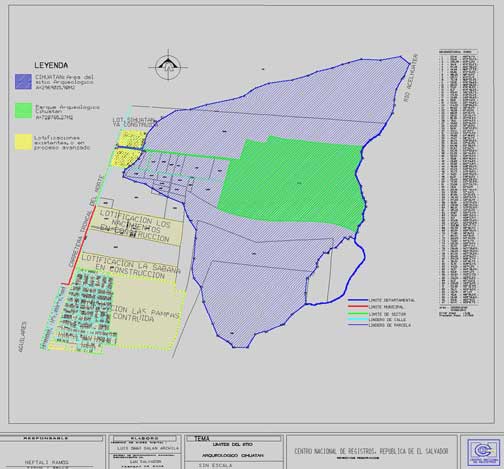
Protection for Cihuatán: Screen capture of the official GIS used by the Centro Nacional de Registro (CNR). The polygon describing Cihuatán's limits is shown in blue and the area of the archaeological park is in green. The table on the right presents the coordinates of each geodesic point of the polygon with the distances between each one. Property lines are also shown.
NOTE: This protection was violated by a construction project denounced by FUNDAR in March, 2010. The project destroyed several prehispanic structures. You can view our report to the Secretaría de Cultura by clicking here. Related newspaper articles can be accessed by clicking here.
Contributions to International Agreements Against Illicit Traffic
El Salvador has been the world leader in establishing bilateral agreements with the United States against the illicit traffic of its archaeological property, and this has been due in large part to the efforts of three of FUNDAR's founding members: Manuel López, Karen Bruhns, and Paul Amaroli.
Legal Background
These agreements are rooted in the Convention on the Means of Prohibiting and Preventing the Illicit Import, Export and Transfer of Ownership of Cultural Property, approved by UNESCO in 1970. The first country to pass enabling legislation concerning this convention was the United States, which in 1987 passed its Public Law 97-446.
This law stipulates that other countries may enter bilateral agreements with the United States, with the goal that the US blocks the import of looted cultural property (this is expressed as the "imposition of US import restrictions on cultural property"). This effort by the US government recognizes that the illicit traffic of artifacts motivates the destruction of cultural sites, and that the US has been a "consumer" of such artifacts.
Public Law 97-446 established the creation of the Cultural Property Advisory Committee, whose members are appointed by the President of the United States. The Committee receives and evaluates requests for import restrictions from interested nations. If a request is approved, the Committee may recommend that the State Deparment take one of two responses: 1) an agreement for Emergency Action, where an urgent situation exists which threatens a site or cultural region, or 2) a Memorandum of Understanding (MOU), with the intention of imposing import restrictions on a wide range of a nation's cultural property. MOUs are semi-permanent in nature, in that they are renewable every 5 years.
In order to new a MOU after 5 years, it is necessary that the interested party demostrate that the import restrictions have been effective in reducing depredation and illicit traffic, and that it has complied with internal measures to combat these problems. Emergency Action agreements also last 5 years, and although the law provides for their possible renewal, procedurally it is preferred that they be replaced by a MOU.
The First Agreement of its Kind: Emergency Action for the Cara Sucia Region in 1987
In the 1980s, Cara Sucia and other sites in the coastal region of the Department of Ahuachapán were being intensively looted. Reports state that some 600 people - entire families - were looting daily at the major site of Cara Sucia, and that there were food vendors and "coyotes" (illicit buyers/sellers) that circulated through the crowd to buy artifacts. Although the massive looting at Cara Sucia was stopped in 1982 when the site was fenced and equipped with guards, depredation continued at many neighboring sites.
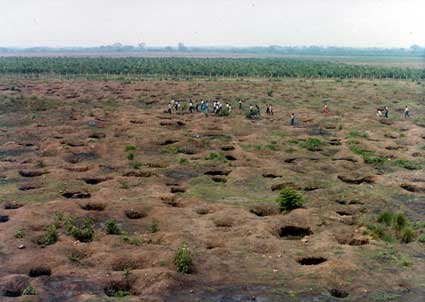
The Cara Sucia archaeological site in 1982. Looters left over 6,000 pits and incalculable destruction.
In 1986, supported by a Fulbright Research Award, Paul Amaroli documented looting at several sites in the Cara Sucia region. He also interviewed locals, coyotes, and collectors in order to describe the network of illicit traffic of looted artifacts, and it was possible to obtain evidence that artifacts looted from the region were being sold in the United States.
Manuel López (then of the Department of Archaeology of the Dirección de Patrimonio Cultural) and Amaroli used this information to write the base document for El Salvador's request to the United States for an Emergency Action agreement. The request was accepted and the agreement was implemented on September 11, 1987. This was the first agreement of its type in the world. Although it was not expected to last longer than 5 years, fortunately it was renewed for 2 additional years, giving the time necessary to request a semi-permanent MOU.
In 1990, Amaroli participated as an advisor (under the Academic Specialist Program of the US State Department) to the Instituto de Antropología e Historia of Guatemala, working with two Guatemalan archaeologists to formulate a request for Emergency Action for artifacts from the Petén region. Guatemala's request was accepted and implemented in 1991.
The First "Permanent" Agreement of its Kind: the MOU of 1995
Working for CONCULTURA in 1994, Paul Amaroli prepared the base document used in El Salvador's request for a MOU (Memorandum of Understanding) for the imposition of US import restrictions on a wide range of archaeological materials. The request was presented in early 1995.
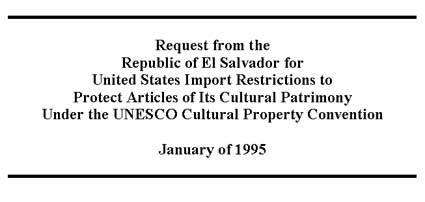
Title page of the 1995 request for US import restrictions under a Memorandum of Understanding (MOU).
The State Department accepted the request and the very first MOU of its kind was implemented on March 10, 1995. The base document included a catalogue illustrating different classes of artifacts as guide for use by customs agents. This information, with revisions, is now posted on the Internet.
Testimony by FUNDAR Archaeologists Representing the Society for American Archaeology
MOUs are of semi-permanent character as described above, being renewable every 5 years. The MOU between El Salvador and the United States was first renewed in the year 2000. When the next renewal date approached in 2005, however, there were doubts about whether another 5 years would be granted or not. In response to the possibility that this important agreement would be allowed to expire, the Society for American Archaeology (SAA) requested that Karen Bruhns and Paul Amaroli (FUNDAR archaeologists) represent the organization with testimony favorable to renewal of the MOU. Their testimony, which was presented to the Cultural Property Advisory Committee, is posted on the SAA's website (www.saa.org) and may also be consulted here. The MOU was renewed on March 8, 2005.
After the passage of another period of 5 years, on March 8, 2010, this critical agreement was once again renewed. Karen Bruhns, on behalf of FUNDAR, contributed a letter of support for this renewal of the MOU (click here to read the letter).
The existence of the MOU has been important in the confiscation and repatriation of Salvadoran artifacts as described under Evaluations of Confiscated Artifacts.
